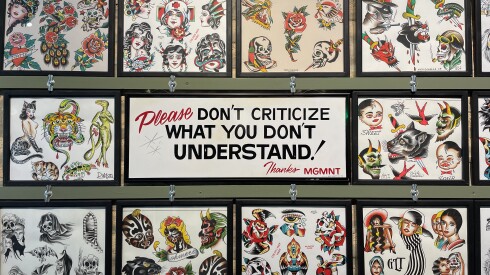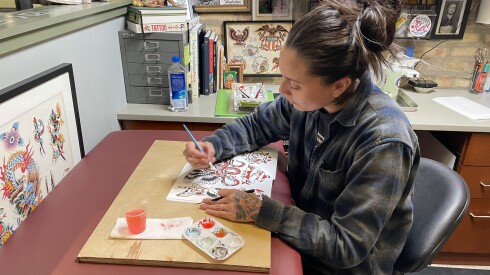Large portraits of tattoo icons Tatts Thomas and Ralph Johnstone watch over Nick Colella as he works.
“Both of those guys tattooed on the 400 block of South State Street where the Harold Washington Library is,” said Colella, owner of Great Lakes Tattoo on Grand Avenue.
Tattoos go way back. The oldest known tattoos are on Ötzi the Iceman, a body preserved in the Alps for over 5,000 years. Tattooing was common in ancient Egypt and is found on mummies, mostly women, who often etched fertility signs onto their bodies.
Chicago is part of that history.
“Chicago plays a vital role in tattooing in the country,” Colella said. “That area of State Street, you had all the sailors come from Great Lakes Naval Base. That’s why this place is called Great Lakes Tattoo. You had this naval training base here where all these sailors in wartime came to train, then went down to State Street to see girls and get tattoos. All the arcades had tattooers. All the burlesque shows had tattooers. This stuff on the walls is all from those arcades.”
The walls of Great Lakes Tattoo are jammed with framed selections of classic art: swooping eagles and beribboned daggers, grinning skulls and flaming hearts. Like any fashion, tattooing goes through phases. Polynesian tribal tattoos were popular in the 1990s, then strands of barbed wire on the upper arm.
But the snarling panthers and cheesecake ladies are always in style.
“That’s pretty much what I do: traditional American tattooing,” Colella said. “That’s what Danni’s doing: repainting in the same tradition they repainted 80 years ago.”
Danni Nievera, at the next stall — 10 artists work at Great Lakes — carefully dabbed red onto a dragon on a sheet of paper.
“I’m just using gouache, adding color,” she said.
I was not there to get tattooed — I have a hard enough time picking out a new pair of glasses — but to visit World Tattoo Gallery, a small exhibit space downstairs, and see a show of Tony Fitzpatrick’s colorful paintings. Tony was heavily tattooed himself, and his art was influenced by tattoo art. Popping in, eyeballing his pictures, then leaving seemed a lost opportunity. So I asked to talk about tattooing while there.
Besides aesthetics, the old designs carry the spirit of their originators.
“I like tattooing off these old designs because that’s what keeps those guys alive,” Colella said. “That’s what the history of it is. That’s the tradition of it. I’m doing their designs in the current manner with better tools and nicer inks.”
What does Nievera, 30, like about tattooing?
“Everything,” she replied, “I love the culture. I love meeting people. I love tattooing.”
And what is that culture?
“The current tattoo culture is very different from when I first started,” said Colella, 50. “Everybody is getting tattooed now. I first started in ’94, it was still pretty underground.”
How did he begin?
“I was a legacy city guy,” he explained, meaning that his father and grandfather worked for Chicago at jobs that back then were — and, OK, sometimes right now are — hereditary. “I was supposed to be a city worker. Now I’m doing this. I’ve been doing this forever.”
What first drew him to tattoos?
“I wanted to get tattoos so no one would talk to me,” he said. “All the tough guys had tattoos in my neighborhood. All my punk rock heroes had tattoos. I wanted to be tattooed like them and didn’t really want to conform. Now everybody talks to me because I’m full of these tattoos.”
The popularity of tattoos has more than doubled over the past 30 years, from less than 15% to a third of Americans.
“It’s a totally different world,” Colella said. “Right now is the best time to be tattooed. Because you can walk into a shop like this, and not have some burly dudes” — he gestured to old photos — “not have to deal with those kind of people.”
Doesn’t the rise in popularity dampen the outsider appeal?
“It obviously has taken the edge off that underground culture and opened it to everyone,” he said. “It used to be a working man’s rite of passage. Now that’s not the case.”
Sailors still come in, looking for classic naval designs. But a lot of art comes off Instagram.
“Everything is pop culture-based,” he said.
So it’s all Pikachu?
“Right, that’s exactly it, unfortunately,” he said. “It’s not my favorite.”
Why do people get a tattoo?
“For the same reason they got it 80 years ago,” he said. “It’s distinguishing. To separate themselves. To memorialize. For love and despair. All of the things.”
Love and despair. Trying to stand apart by doing what everyone does. You can’t get more human than that.

